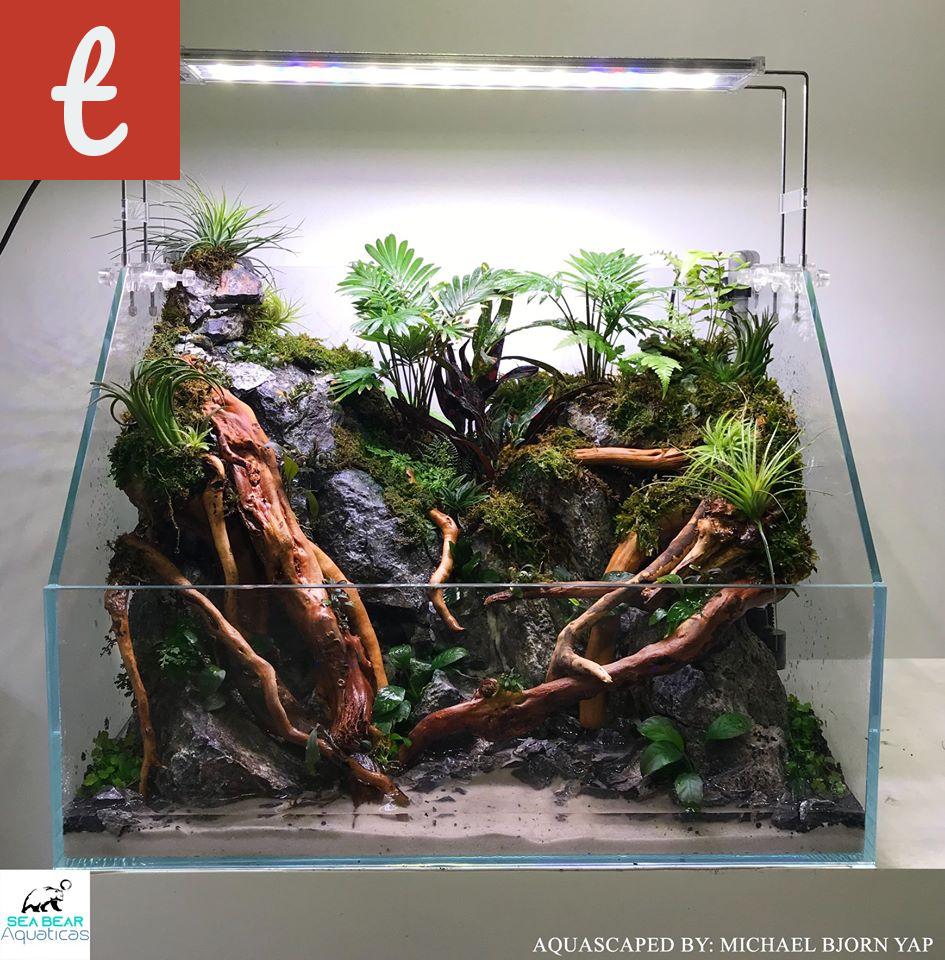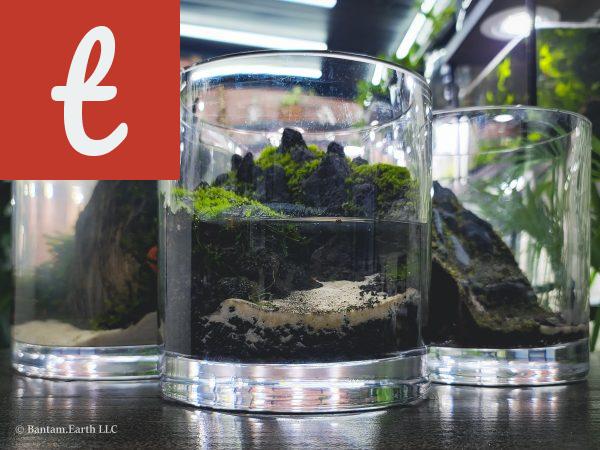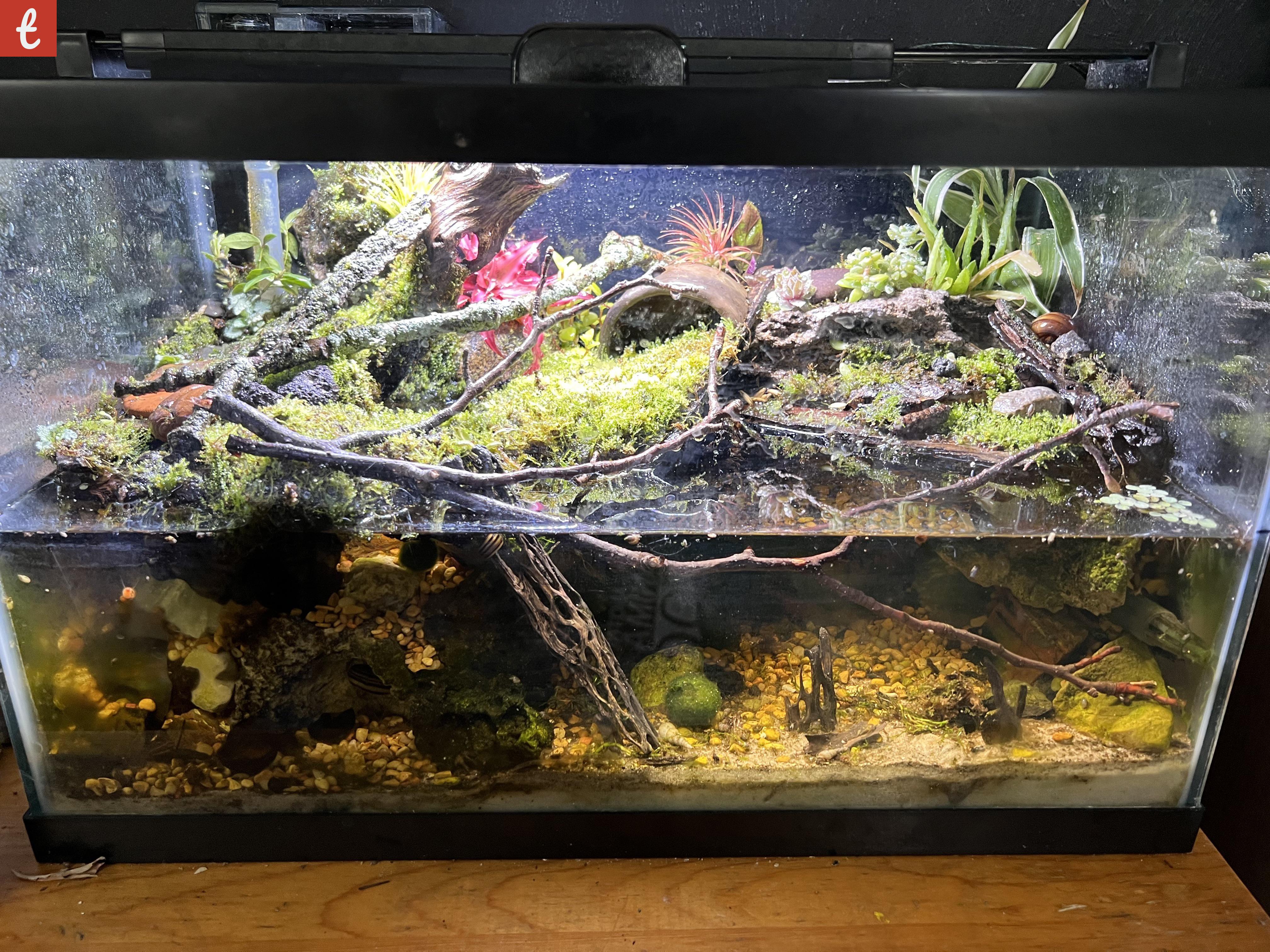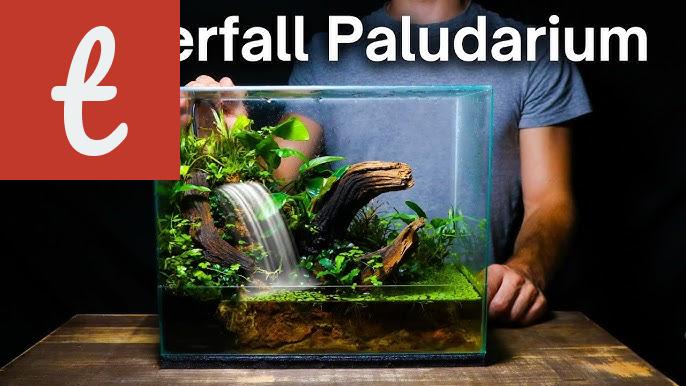The Ultimate Guide to Creating a Small Paludarium in Your Home
Interested in adding a unique and captivating element to your home? Look no further than a small paludarium! A paludarium is a combination of a terrarium and an aquarium, creating the perfect habitat for both land and aquatic plants, as well as a variety of small animals. In this guide, we'll walk you through the steps of creating your very own small paludarium.
1. Choose the Right Container:
First things first, you'll need to select a suitable container for your paludarium. It should be made of glass or acrylic and have a tight-fitting lid to maintain humidity. The size of the container will depend on the space you have available and the type of plants and animals you wish to include.
- List item 1: If you're a beginner, start with a small container to make maintenance easier.
- List item 2: Make sure the container has adequate ventilation to prevent mold and mildew.
2. Plan the Layout:
Before diving into the design, carefully plan how you want your paludarium to look. Consider the types of plants you'll use, the positioning of water features, and any decorations or rocks. This step will help you visualize the final product and make it easier to bring your vision to life.
3. Prepare the Environment:
Thoroughly clean the container before setting it up. Remove any labels or stickers, and rinse it with warm water to remove any dirt or debris. Fill the bottom with a layer of gravel for drainage, followed by a layer of soil or sand suitable for plant growth.
4. Install Water Features:
Depending on the size and complexity of your paludarium, you may want to include a water feature. This could be a small pond, a cascading waterfall, or even a flowing river. Ensure that the water feature is properly sealed to prevent leaks and make sure to use water suitable for the specific organisms you plan to keep.
5. Choose the Right Flora:
Now it's time to select the plants that will thrive in your paludarium. Choose plants that are appropriate for a humid environment and can thrive in both submerged and emersed conditions. Options include ferns, mosses, aquatic plants, and even carnivorous plants. Ensure that they are compatible with the animals you plan to introduce.
6. Add the Fauna:
If you're interested in including animals in your paludarium, choose small species that are suitable for the size of the container and compatible with the plants you've selected. Consider frogs, snails, shrimp, or small fish. Research the specific needs of each species and provide appropriate hiding places, food, and water parameters.
7. Maintain and Enjoy:
Once your paludarium is set up, it's important to maintain it properly. Monitor the temperature, humidity, and lighting regularly to ensure the health and well-being of your plants and animals. Keep an eye out for any signs of distress or changes that might require adjustments to the environment.
In conclusion, creating a small paludarium can be a rewarding and aesthetically pleasing addition to your home. Following these steps will help you create a thriving ecosystem that can provide endless enjoyment and beauty. So, get ready to dive into the fascinating world of paludariums and let your creativity flourish!
Step-by-Step: Building a Compact Paludarium for Your Home
Are you a nature lover who wants to bring a piece of the wild into your home? A paludarium could be the perfect solution for you. A paludarium is a type of vivarium that consists of both land and water sections, creating a unique habitat for plants, fish, and other small animals. Building a compact paludarium can be a rewarding and enjoyable project that allows you to create a mini-ecosystem within the confines of your own home.
Before you begin, there are a few things to consider. First, decide on the size of your paludarium. A compact paludarium is ideal for those with limited space or for beginners who want to start small. Next, think about the type of plants and animals you want to include in your paludarium. Research their specific requirements regarding lighting, temperature, and humidity to ensure their well-being.
- Choose a suitable container:
The first step in building your compact paludarium is to choose a suitable container. You can use a glass aquarium, terrarium, or even a plastic storage box. Ensure that the container is watertight and has a secure lid to prevent any potential escapees.
- Set up the land and water sections:
Once you have your container, it's time to set up the land and water sections. Use a substrate like peat moss or coco fiber for the land section, and create varying levels of elevations to add visual interest. For the water section, use a sturdy pond liner or aquarium-safe silicone to create a barrier between the land and water.
- Add plants and decorations:
Now comes the fun part - adding plants and decorations. Choose plants that are suitable for both the land and water sections of your paludarium. Some popular choices include aquatic mosses, ferns, and small carnivorous plants. You can also add rocks, driftwood, and other natural decorations to create a more realistic and visually appealing habitat.
Remember to place a sturdy branch or rock that reaches from the land section into the water section, as this will provide an easy access point for animals.
- Introduce fish, amphibians, or invertebrates:
If you wish to include fish, amphibians, or invertebrates in your paludarium, research the specific species you want to add. Ensure that the water conditions and temperature are suitable for them. Fish like guppies and dwarf rasboras, as well as small frogs and snails, are popular choices for paludariums.
Before adding any animals, it's important to establish a stable ecosystem within the paludarium. Monitor water parameters, such as temperature, pH, and ammonia levels, to ensure they are within the appropriate range for your chosen inhabitants.
Regular maintenance is crucial to keep your compact paludarium thriving. This includes monitoring and adjusting lighting, temperature, and humidity levels, as well as regular cleaning of the water section and trimming of plants.
In conclusion, building a compact paludarium can be a rewarding and fascinating endeavor. By following these steps and conducting thorough research on the specific requirements of your chosen plants and animals, you can create a beautiful miniature ecosystem in your very own home. So go ahead, grab your tools, and dive into the world of paludariums!
Main Title
Are you looking for a unique and intriguing addition to your home decor? Look no further than a mini paludarium! This enchanting miniature ecosystem combines the beauty of a terrarium and an aquarium to create a captivating display of nature's wonders right in the comfort of your own home. In this step-by-step guide, we will walk you through the process of creating your very own mini paludarium.
Before we delve into the steps, let's understand what a mini paludarium is. It is a small-scale enclosed environment that contains both terrestrial and aquatic elements. These miniaturized ecosystems mimic the natural habitats of certain plant and animal species, allowing you to observe their fascinating behaviors up close.
- List item 1: Choose the right container - The first step in creating a mini paludarium is selecting the ideal container. It can be a glass container, a fish tank, or even a specially designed enclosure. Ensure that it has a secure lid to maintain the proper humidity levels and prevent any critters from escaping.
- List item 2: Plan your layout - Once you have your container, it's time to plan the layout of your mini paludarium. Consider the size of your plants and animals and create different levels and zones. You can use rocks, driftwood, or other decorative elements to add depth and visual interest.
Now that you have your container and layout ready, it's time to bring your mini paludarium to life! Here are a few more essential steps:
- List item 1: Create a drainage layer - Since a mini paludarium consists of both water and land areas, it is essential to create a proper drainage layer. This layer will prevent waterlogging and ensure that excess water does not harm your plants.
- List item 2: Add substrate - Next, add a suitable substrate for your plants. Consider the needs of the species you plan to incorporate. Some plants prefer well-drained soil, while others thrive in aquatic conditions. Make sure to research and choose accordingly.
- List item 3: Install lighting and heating - Plants in a mini paludarium require adequate lighting and, in some cases, heating. Choose the right type of lighting, such as LED lights, and ensure they are placed strategically to provide the necessary amount of light. Temperature requirements vary among different plants and animals, so research and adjust accordingly.
- List item 4: Introduce plants and animals - The highlight of a mini paludarium is the living organisms. Carefully select plants and animals that thrive in a moist, semi-aquatic habitat. Some popular choices include ferns, mosses, aquatic plants, and small aquatic creatures like shrimp or snails.
- List item 5: Maintain and monitor - Once your mini paludarium is set up, it's important to maintain and monitor its conditions regularly. Ensure that the water levels are appropriate, humidity is maintained, and the temperature is suitable for the inhabitants. Regular pruning, watering, and cleaning are essential parts of maintenance.
In conclusion, a mini paludarium is an eye-catching and fascinating addition to any home. It provides an opportunity to observe the beauty of nature up close while adding a unique touch to your decor. By following the steps outlined in this guide, you can create the perfect miniature ecosystem that will leave your guests in awe.

Creating a Small Paludarium: Tips and Tricks for a Stunning Home Aquascape
Aquascaping has become increasingly popular among hobbyists, and one trend that has caught the attention of many is the creation of small paludariums. A paludarium is a unique combination of an aquarium and a terrarium, creating a beautiful mini-ecosystem that mimics a natural habitat for both aquatic and terrestrial plants and animals. If you're looking to enhance your home with a stunning paludarium, here are some tips and tricks to help you get started.
1. Planning is Key: Before diving into the creation process, it is important to spend time planning and visualizing your paludarium. Consider the size, shape, and location of the enclosure and determine the type of ecosystem you want to create. Will it be a jungle-themed paludarium with lush vegetation and a small waterfall? Or perhaps a desert-themed one with rocks and cacti? Having a clear vision will help guide you throughout the construction process.
2. Selecting the Right Plants: The choice of plants is crucial for a successful paludarium. Select plants that are well-suited to the specific environment you want to create. Research the plants' compatibility with the lighting and humidity levels in your paludarium. Choose a variety of aquatic plants that can thrive in water and terrestrial plants that can adapt to the dry conditions. This diversity will create a visually appealing and ecologically balanced environment.
- Floating plants: Floating plants like Water Lettuce and Amazon Frogbit not only add beauty to the paludarium but also provide shade and cover for the aquatic inhabitants.
- Aquatic plants: Consider plants like Anubias and Java Fern, as they can be partially submerged and will provide a natural look to the underwater area of the paludarium.
- Terrestrial plants: Spider Plant and Pothos are popular choices due to their ability to grow in both submerged and emersed conditions.
3. Creating the Hardscape: The hardscape elements, such as rocks, branches, and driftwood, play a vital role in the overall aesthetics of the paludarium. Arrange these elements to create natural-looking landscapes and provide ample hiding spots for the inhabitants. Ensure that the hardscape materials are aquarium-safe and won't leach harmful substances into the water.
4. Water and Lighting: Paludariums require a balance of both aquatic and terrestrial environments. Ensure that there is a suitable water source for the aquatic plants and animals. Depending on the type of paludarium you are creating, you may need to install a small pump or filter to maintain water quality. Additionally, choose the right lighting for your paludarium to support the photosynthesis process of your plants.
5. Adding the Inhabitants: Once your paludarium is set up and stabilized, you can carefully introduce suitable aquatic and terrestrial inhabitants. Choose small fish, such as guppies or tetras, that can live comfortably in the water portion. For the terrestrial section, consider frogs, small lizards, or insects, depending on the size of the enclosure and the specific requirements of the species.
The creation of a small paludarium is a fascinating and rewarding journey for any aquascaping enthusiast. With careful planning, the right plant selection, and proper maintenance, you can create a stunning miniature ecosystem that will surely be the centerpiece of your home. Get started today and let your creativity flow!
The Art of Designing a Smallest Paludarium: Ideas and Inspiration for Your Home
Are you looking to add a touch of nature to your home? A paludarium could be just what you need! A paludarium is a unique and eye-catching hybrid of an aquarium and a terrarium, combining aquatic and terrestrial elements to create a mini-ecosystem. If you have limited space, don't worry! In this article, we will explore the art of designing the smallest paludariums, giving you ideas and inspiration for your home.
When it comes to designing a small paludarium, the key is to maximize the use of vertical space. Think of it as a miniature jungle where plants, water, and animals coexist harmoniously. Here are some tips to get you started:
- Selecting the Right Container: For small paludariums, glass containers are an excellent choice. Look for one with a lid or cover to control humidity and prevent any possible escapes by your pet or plants. A jar, vase, or even a repurposed fish tank can work well.
- Choosing the Perfect Plants: Opt for plants that thrive in both wet and dry conditions. Mosses, ferns, and air plants are ideal choices as they require minimal maintenance and adapt well to different moisture levels. Consider using hanging plants to save space.
- Introducing Water: A paludarium is not complete without water. A small pond or water feature can be incorporated into your design. Use aquatic plants like water lilies or floating plants like duckweed to create a natural and serene atmosphere.
- Selecting the Right Animals: If you'd like to add some companions to your paludarium, choose small and hardy creatures that can thrive in a confined space. Frogs, snails, or small species of fish like guppies or endlers can be excellent choices. Ensure you provide them with suitable hiding spots and a balanced diet.
With the basics covered, it's time to get creative and design your small paludarium like a work of art:
1. Micro Landscapes: Use small rocks, branches, and driftwood to create elevated surfaces, adding depth and visual interest to your small paludarium. These micro landscapes also provide hiding spots for animals and create additional planting areas.
2. Terracing: Utilize different levels within your paludarium to create a terraced effect. This adds a unique dimension to your design while maximizing the use of available space. Install small platforms, shelves, or use stacked rocks to create these terraces.
3. Focal Point: Create a focal point within your paludarium to draw attention. This could be a small waterfall, a rock formation, or a vibrant plant. Whatever you choose, make sure it stands out and adds visual appeal to your mini-ecosystem.
4. Lighting: Proper lighting is essential for the health of your plants and animals. Choose LED lights that mimic natural sunlight, providing both warmth and light. Experiment with different lighting angles to create shadows and enhance the overall aesthetics of your paludarium.
Remember, the key to designing a smallest paludarium is to find a balance between the various elements and create a visually appealing mini-ecosystem. Regular maintenance and monitoring are important to ensure the health and well-being of your plants and animals.
So, unleash your creativity and start designing your own smallest paludarium today. Transform a corner of your home into a captivating and tranquil oasis that will be the envy of all your visitors!




Comments on "How To Create The Smallest Paludarium For Your Home"
No comment found!